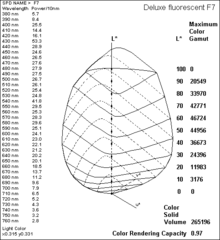- Color Rendering Capacity
-
Color Rendering Capacity
How many colors on earth is a given light source capable of vividly rendering? Under what type of light source can a scene be made the most colorful? Such questions highlight a particular aspect of the color rendering quality of light sources,[1] an aspect relating to the concern of whether differently colored objects under illumination of a certain light source can appear in colors that are significantly different from each other and occupying a wide range of colors. The color rendering capacity is one of several measures of the color rendering quality of light sources, specially devised to be able to answer the above questions.
The idea of the color rendering capacity can be introduced as follows: Associated with each type of spectral power distribution, one and only one color solid can be constructed in a uniform color space.[2] It has been proved that this color solid comprises all the object colors producible under illumination of that spectral power distribution with one unit luminous flux,[3] and the volume of the color solid determines the upper limit for the number of the object colors producible under the given spectral power distribution with one unit luminous flux.[4] This volume of the color solid associated with the spectral power distribution is called the color rendering capacity.[5]
Calculating the color rendering capacity of a light source, i.e. calculating the volume of the color solid associated with the spectral power distribution of the light source, involves a tedious process. A simple program, CRC99, has been available, enabling the color rendering capacity of any light source to be figured out in a few seconds. Note that the color rendering capacity given by CRC99 is actually the volume of the color solid associated with the given spectral power distribution divided by the volume associated with equal energy spectrum. As a result, the color rendering capacity now is an easily remembered and mutually comparable figure proportional to the volume instead of a long string of numerals representing the volume itself. For example, the color rendering capacity now is 0.35 for high-pressure sodium lamps, 0.97 for Deluxe fluorescent lamps, and 1.00 for equal energy spectrum respectively. These results conform with everyday experiences: Fewer high pressure sodium lamps than deluxe fluorescent lamps are found in department stores for commodity lighting, mainly because the commodities under high pressure sodium all appear in monotonous yellow shades while the same commodities under deluxe fluorescent, at the same light level, display a variety of colors, and the resulting colorful scene appeals to customers more strongly. The color solid and the color rendering capacity calculated for the spectrum of the Deluxe fluorescent lamp F7 is shown on the right.
Notes
References
- MacAdam,DL (1981). Color Measurement, Springer-Verlag. ISBN 0-387-10773-8
- Commission Internationale de l'Eclairage (1986). Colorimetry, CIE.
- Xu, H (2008). "Correspondence: Colour rendering capacity", Lighting Research and Technology, 257(40).
- Xu, H (2010). Color Rendering Capacity of Light, Lulu Enterprises. ISBN 978-0-557-29359-9
External links
Categories:
Wikimedia Foundation. 2010.

